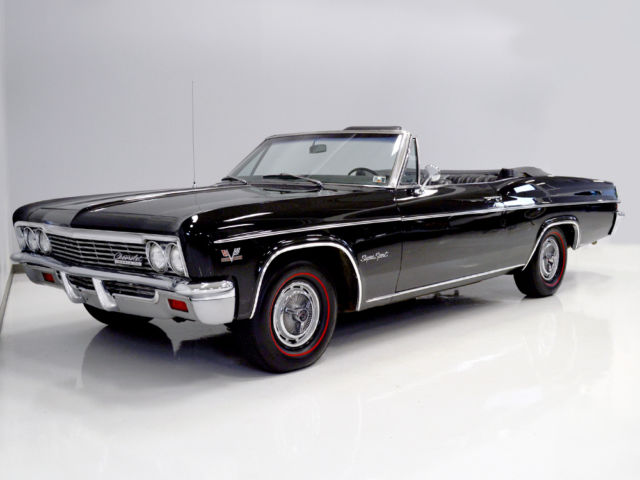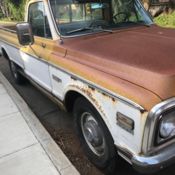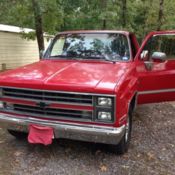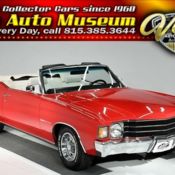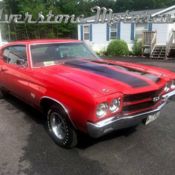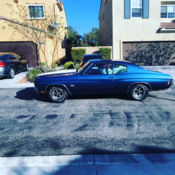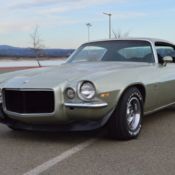SS427, 28,457 original miles, matching-numbers, build sheet, loaded with options
1966 Chevrolet Impala SS427
This beautiful triple-black 1966 Chevy Impala SS combines some of the hottest things in the car hobby: 427 cubic inches, matching-numbers, survivor status, and a bulletproof pedigree. It’s one of those awesome discoveries that many of us wish we could stumble onto, but which so rarely happen. This big Imp ragtop went into hibernation in 1980 with just 28,000 miles on the clock and was not unearthed until recently. During that time, it was in protected storage, waiting for the right moment when it would be appreciated for its incredible low-mileage condition. Today, with survivors being red hot, this is one of the most thoroughly original and unmolested cars we’ve ever seen, and the fact that it’s a rare SS427 convertible with a cool (and unlikely) combination of options only makes it that much sweeter. From the L36 427/390 to the quadraphonic stereo to the power windows, if you’re a fan of untouched and unusual cars, this one is going to get your attention in a big way.
This car is wearing the same Tuxedo Black paint that was sprayed on at the Wilmington, Delaware factory back in January 1966, and it looks fantastic. When it came out of storage, we felt sure that it was going to need a repaint, but thanks to a lot of hand polishing and careful buffing, the factory enamel paint is bright, shiny, and in excellent condition. No, it's not perfect, showing some very minor checking and micro-blistering, but it's extremely good and repainting it is just inconceivable. Great gloss, no accident damage, and everything fits together just the way the factory did it. Of course, the car was used as a real car back in the 1960s and was sold new in Pittsburgh, PA, so there are two quarter-sized rust spots behind each rear wheel well. We opted to leave them alone rather than fix them because 1) it's cosmetic, not structural, and 2) if we fixed and painted the quarters, a buyer might wonder what else we covered up. No, better to leave it all in the open. And honestly, you won't even notice it unless you go looking for it—I didn't even notice the spot on the passenger's side until we'd had the car for a few weeks. But that's the deal. Survivors are like that—you don’t get to choose perfection, but sometimes it’s the imperfections that make them special.
Chrome is excellent. Grille is like new. Emblems are sparkling. Stainless looks great. No pitting, no dings. The car just sparkles in the sun and looks highly detailed from any angle thanks to the contrast between the black paint and bright trim. The crossed-flag badges on the front fenders are bright and crisp with no pitting and the all-important ‘427 Turbo-Jet’ lettering, and the beautiful trunk trim seems to glow from within when the light hits it just right. Lenses, glass, and even the weather seals remain in excellent condition befitting a top-flight survivor.
The interior is likewise 100% original, including the carpets. To get it looking its best, everything came out, the carpets got pressure-washed and steam cleaned, then hung up to dry in the sun. They came out almost like new. Seats were cleaned and conditioned and the trim was polished up. Everything works, including the auxiliary gauges in the center console, the tach, all four power windows, and even the AM/FM stereo radio with "Quadraphonic Sound" that the "experts" say just wasn't available on convertibles. Why? Because the rear speakers interfere with the glass rear window of the convertible top, which is true. But this car comes with the original warning tag saying that the window must be unzipped and tucked under the speakers before the top is lowered. So there's that. Experts, eh?
Speaking of the top, it's new. The original was so brittle and old that the rear window was falling out of the curtain. They tried to replace just the window, but the top shop said there was nothing to connect it to, so everything was replaced. It fits beautifully, powers up and down without issues, and latches to the windshield easier than any other convertible I've ever experienced. There's a matching boot that gives it a clean, sleek look and doesn’t need a lot of fighting to install.
The trunk is spotless. The original mat couldn't be salvaged, but I believe that's the original spare and jack assembly, and a reproduction mat is easy to find and inexpensive. The original warning label indicating that this car has Positraction is still attached to the bottom of the deck lid.
The engine is the original, numbers-matching L36 427 cubic inch V8 making 390 horsepower. We know this because the stamping pad has a partial VIN (it matches) as well as a T1228IJR stamping which decodes as follows: T=Tonowanda assembly plant, 1228=December 28 assembly date, IJ=L36 427/390 engine, R=Rochester carburetor. It's the real deal. Yes, it's crusty, but we degreased, cleaned, scrubbed, and washed it so it's clean. We didn't repaint anything and didn't remove any rust or scale because where do you stop? This is about preservation, not restoration. Things like the belts, hoses, tune-up parts, and battery are new, and the radiator couldn't be saved, so there's a reproduction unit in there now. It also has interesting cables wrapped around the engine mounts and exhaust manifolds that were installed by the dealer according to a service bulletin (which is included with the car).
It runs beautifully. You can stand next to the car, reach in, turn the key, and it starts almost instantly, even when it's cold. It settles into an even idle at about 1100 RPM, and a few seconds later, drops itself down to about 800 RPM. It's effortless, not racy like you'd expect from a 427, and torque is the name of the game. It's smooth, it's quiet, there are no squeaks or rattles, the doors latch closed without a slam, and it feels very tight. THIS is why original cars are special—nothing else drives the same as a car that hasn't been taken apart. Come drive it and suddenly you’ll understand just how good cars really were in 1966.
The engine is linked to a TH400 3-speed automatic with fresh fluid and filter inside, and there are 3.36 gears on a Posi in the 12-bolt out back (new fluid there, too). The brakes are new from the master cylinder to the wheel cylinders, but the original master was rebuilt rather than replaced, so it looks right. All the lines are stainless steel, including brake lines, fuel lines, and the new transmission cooler lines. There's a new gas tank out back for obvious reasons, and there's a fresh reproduction exhaust system that has just the right sound, not some goofball Flowmaster setup. Bushings in the suspension were selectively replaced, including the sway bar end links, but the rest are in great shape and give the car that firm, buttoned-down feeling on the road. It's a little crusty underneath, but there is zero rust-through on the floors or structural areas—this is a VERY solid car with no issues. It's also wearing a set of 225/75/14 Coker redline radials instead of the original whitewall bias-plys because we like the look and they make a big improvement in ride and handling. I don't care if it's correct, this sucker looks badass.
Documentation is extensive, starting with the original build sheet that’s in excellent condition and 100% legible. It fully confirms that this is a real SS427, confirms the matching-numbers engine, and confirms the unusual combination of options. We also have the original owner’s manual, radio operation instructions, warning tags for the top and speakers, and a TSB about those interesting cable tie-downs on the engine mounts, proving it was a OEM upgrade. We’ll also include a few photos of the car when it was found and you can see what a remarkable transformation has taken place.
You’re reading these words but you’re ignoring what I’m saying and instead thinking about how much it’ll cost to detail the engine or what a pain it will be to fix the little rust spots on the quarters. Let me help you: it’ll cost nothing, because you shouldn’t do it. It’s a mistake to restore survivors like this. In this hobby, we’re so busy chasing cosmetic perfection that we overlook what these cars were and what they should be, trying to make them into some vision of perfection that they never attained even when they were new. This is a remarkable car because it’s preserved, not restored, and drives like it did in 1966. Our shows and clubs are full of cosmetic perfection that don’t run or drive very well and that’s probably why survivors are so popular right now. They’re living, breathing proof that old cars weren’t rattle traps with sloppy handling and lousy brakes. One drive in this car will prove that even entry-level GM cars in the 1960s were incredibly well built. Forget perfection and invest in reality instead!
- Condition: Used
- Make: Chevrolet
- Model: Impala
- SubModel: SS427
- Type: Convertible
- Year: 1966
- Mileage: 28,457
- VIN: 168676Y153549
- Color: Black
- Number of cylinders: 8
- Fuel: Gasoline
- Transmission: Automatic
- Interior color: Black
- Options: Convertible
- Vehicle Title: Clear Want to buy? Contact seller!
